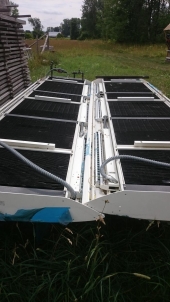posted 9 years ago
We live in a 30' yurt (from Pacific Yurts) in the Kootenays in BC, Canada. For the first two winters we used a Pacific Energy wood stove. The down sides were that it was harder to regulate the temperature (it got too hot at times, and heated inconsistently throughout the yurt w/ hot and cold pockets) and once the fire went out, it got cold very rapidly. The up sides were that it heated the place quickly and it was nice to watch the fire through the window on a cold winter's night.
Last September we installed a Rocket Mass Heater and moved the wood stove out into the storage shed. Unfortunately, we have had some design issues (if you decide to build one, make sure you either research it really thoroughly or consult w/ people like Erica and Ernie Wisner, who really understand RMH's). Regardless, we still really love our RMH for different reasons than we do the wood stove. We love the rustic look of the RMH (we built cob stairs in ours leading up to a loft we constructed) and that it lets off a nice, steady heat over a longer period of time. It is great for rising bread or making yogurt or kombucha. It is wonderful to get up on a cold morning and "cuddle up" to the RMH... our cats love it too for that reason. But we found that in a yurt we have to feed it pretty constantly to keep things warm enough, and this also presents a challenge when we went out for the day/evening and had to come home to a very cold place. Also, while our wood consumption is perhaps less than w/ the regular wood stove, it is not as much less as we had hoped for (it might be different in an insulated structure). But perhaps the greatest drawback is that, with the RMH alone, it takes a very long time to heat the place up (3 or 4 hours) on a cold morning, so we want to either stay in bed or stay huddled on the RMH... forget facing the world! So midway through the winter we ended up buying a lovely kerosene heater to compliment the RMH and heat the place up quickly. The two work quite nicely in tandem, but kerosene is definitely a little more costly to run.
Just today, in preparation for the coming winter, we moved our old wood stove back in, and we are looking forward to having it up and running again. As the temps have been starting to drop, we have not yet been running the RMH due to the "design issues" previously mentioned (the Wisners have since given us some remediation suggestions which we will attempt to implement before winter hits). We hope, however, to use the two technologies together, and I suspect that, the combination will be the best that we can achieve in a yurt.
My best guess is that for someone looking for the most comfortable and efficient way to heat a yurt (assuming you can afford it), either a very slow burning Blaze King Princess (though I cannot claim to have ever used one), or the combination of a wood stove and a RMH, is the way to go.









 1
1


















 1
1















